Mar-14-13
 | | Honza Cervenka: 30...g4?? was a blunder. Marshall missed a nice opportunity to draw by perpetual after 30...Nh3+! 31.Kg2 Nf4+ 32.Kh1 (32.Kg3 Nh5+) 32...Nh3! (Threat 33...Bf3# forces white to agree with repetition as 33.Rg1? Bf3+ 34.Rg2 Nf4 loses.) 33.Kg2 etc. |
|
| Mar-14-13 | | Abdel Irada: As usual, <Honza>, I can find no flaw in your analysis. Unfortunate that Marshall couldn't have had you as a second. :-) |
|
Jun-06-22
 | | KEG: Maroczy was battling for first place with Janowski and Pillsbury while Marshall was just behind that trio as the players sat down for this 9th round game. Marshall and Maroczy had played once before, in the final round at Paris 1900, where Maroczy won and brought Marshall down into a tie with him for third place and allowed Pillsbury (whom Marshall had defeated at that event) to take 2nd (behind Lasker). The game at hand here was an exciting affair, with Marshall trying all sorts of desperato combinations against Maroczy. The latter seemed uncharacteristically ruffled by Marshall's roughhouse tactics, and missed several opportunities to win the game at an early stage. As a result of a mistake by Maroczy on move 29, Marshall had a draw in hand by perpetual check (as was shown nicely on this site by <Honza Cervenka>nine years ago) but erred on his 30th move--perhaps thinking there was more in the position. After that, Maroczy's King walked a scary looking tightrope and emerged victorious. Not the most accurate chess, but quite a fun game to play over and analyze. 1. e4 e5
2. Nf3 Nf6
Marshall liked to play the Petroff as Black early in his career, and had some fine tactical wins with this opening. 3. Nc3
Maroczy probably wanted no part of a tactical shoot-out with Marshall (though that was what ensued anyway) and opted for the normally symmetrical Four Knights' Game, likely expected that he would have the edge in a quiet game. 3... Bb4
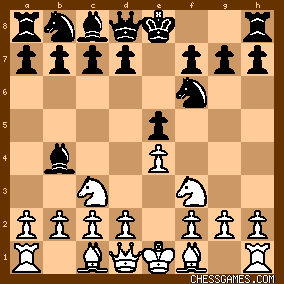
click for larger viewMarshall wanted action, not a placed Four Knights' game and thus chose this unusual form of the Three Knights' Game. Marshall tried the same strategy when he played Maroczy as Black in Round 6 at New York 1924. As here, Marshall staked all on a wild sacrificial attack, and suffered the same fate (a loss) as he did here, albeit in that case only after a much longer (81 move) struggle. The text (3...Bb4 has not been treated kindly by the critics. Both the Tournament Book here and Alekhine (in annotating the Maroczy-Marshall game at New York 1924) noted that the 3...Bb4 version of the Three Knights' Game has the disadvantage of allowing White to obtain the two Bishops (since Black pretty much has to trade Bishop for Knight to regain the pawn after 4. Nxe5). That all being said, the opening is not all that bad for Black and is entirely playable. 4. Nxe5
At New York 1924, Maroczy played 4. d3 here, a move mocked by Alekhine as "in no way intended to retain the advantage of the opening." The text, and 4. Bc4 (which is also good for White) are the most normal lines against 3...Bb4. 4... 0-0
5. Be2
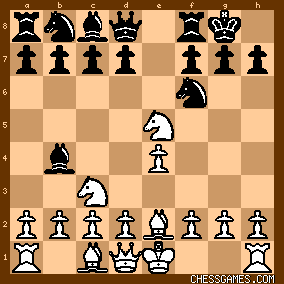
click for larger viewA subtle move, retaining some advantage but taking no risks. It seems to side-step the likelihood of tactical fireworks, but that's no how it worked out here with Marshall at the helm as Black. 5... Re8
6. Nd3 BxN
7. dxB Nxe4
8. 0-0 d5
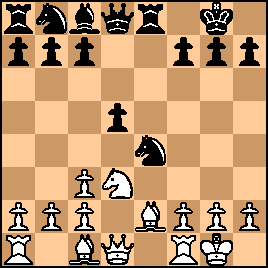
click for larger view9. Nf4
One might have expected the simpler 9. Re1 from Maroczy than this fourth move by the White Knight. 9... c6
9...Nf6 looks like an easier way to equalize. But Marshall wanted ACTION, and he soon got it. 10. Be3
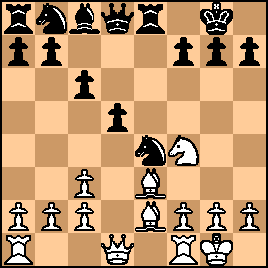
click for larger view10. Re1 or 10. c4 may be somewhat better, but the text was sufficient for Maroczy to retain a small edge with his two Bishop, and thus far the game was probably shaping up in accordance with his expectations and liking. But everything turned topsy-turvy after Marshall's next move. |
|
Jun-06-22
 | | KEG: Post II
10... f5?!
Typical Marshall at this stage of his career. After his triumph (a tied for 3rd at Paris 1900) two years earlier, Marshall played as if he thought he could blow his opponents away with tactics. This didn't work out well for him during 1901-1903, and it was not until Cambridge Springs 1904 (the highlight of Marshall's career) that he figured out how to use yet tame his tactical prowess. But along the way, not being Tahl, Marshall suffered numerous painful setbacks. Here, 10...Bd6 or 10...Nd7 would have given Marshall a decent (although slightly inferior) game. In that, however, Marshall seemed to have no interest. 11. c4!
Nicely undermining Marshall's position and giving Maroczy something near to a strategically won game: 
click for larger view11... g5?!
Marshall seemingly had to submit to trading off his other Bishop with 11...Be6. But he apparently wanted to go for the kill immediately (even with his Queen-side pieces undeveloped and his King at best minimally defended). This could have led to a quick catastrophe for Black here. 12. Nh5
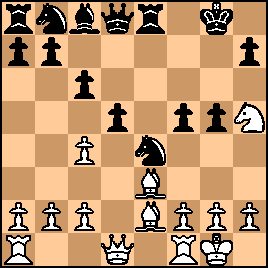
click for larger view12... f4?!
"?"--(Tournament Book)
Like the Tournament Book, I am no great fan of this move. But everything else is likewise terrible. At this stage, the text may have been the best practical chance. And indeed, Maroczy blinked. The position was now:

click for larger view13. Qd4?
The Tournament Book claimed that 13. Bxa7 was best, suggesting that 13...RxB would now be a mistake in light of of 14. Qd4. But this is all wrong. 13. Bxa7 would have been a terrible mistake and would have given Marshall exactly what he wanted. If 14. Qd4 the notion that Black must lose his Rook to avoid mate is exploded by 14...b6! which leaves White down a piece and probably lost. Best for White after 13. Bxa7? RxB is 14. cxd5 cxd5 15. Qd4 b6 16. Bb5 with attacking chances for the lost piece. But even if White could thereby save the game it hardly renders 13. Bxa7 a decent move. Best for White here, and probably yielding a won game, is 13. Bd4! After the text (13. Qd4?), White is still better, but hardly winning. 13... Qe7
14. Bc1
White is also better, but facing substantial complications, after 14. Bxf4 gxB 15. f3 Nd2 16. Nf6+ Kf7 17. NxR NxR 18. KxB KxN 19. cxd5 Nd7 20. dxc6 bxc6 21. Bb5! Kd8 22. Bxc6 Rb8 23. BxN BxB 24. b3 with three pawns for the sacrificed piece and chances to harass the remaining scattered isolated Black pawns. The text is probably a simpler way for White to try to exploit his advantage. The position was now:

click for larger view14... Be6?!
More wild play by Marshall. He could probably have survived with 14...Qe5. But Marshall wanted more. 15. b4
This may be good enough to keep White well on top, but 15. h4! was the way to punish Marshall, who would have been lucky to avoid defeat after that superior move. 15... c5!
The only move, but a good one. It left:

click for larger viewQuite an interesting position. White may still have a theoretically won game, but over-the-board this is a tough situation to try to find the best moves. In any case, Maroczy erred here, seemingly forfeiting all of his advantage, but then Marshall--still looking for a haymaker--and was soon in a losing endgame which, though complicated, was just the sort of ending in which Maroczy usually prevailed. But then...things really got crazy. |
|
Jun-07-22
 | | KEG: Post III
16. bxc5?
Maorczy likely had the game in hand before this lemon. But he had to play 16. Qd3! here. After the text, Marshall had surmounted his troubles and had--at the very least--equalizing counter-chances. 16... Nc6
17. Qb2
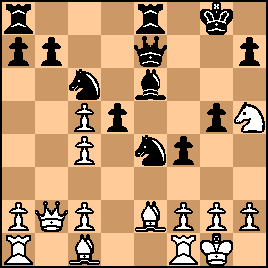
click for larger view17... dxc4?
Maroczy's Queen-side pawns were a mess and there was no reason to hurry to start snatching his tripled c-pawns. Instead, Marshall should have pressed with 17...d4! The text gave White the chance to regroup. 18. Bf3 c3
19. Qa3

click for larger viewMarshall was still very much in the game. But he (at least theoretically) ruined his chances with the unsound hyper-aggressive: 19... Nd4?
19...Bf7 would have solved a good deal of Marshall's problems. Marshall's actual move was even worse than it seems, because--as revealed by his next move--Marshall had an ingenious but flawed attacking scheme characteristic of his wild and unsound play in 1901-1903. 20. BxN
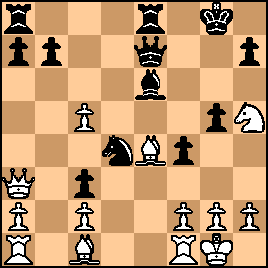
click for larger view20... Ne2+
This superficially plausible move in fact forced Maroxy to reduce to a winning endgame...for White!. Marshall's best chances lay in 20...Qf7. After the text the game fell apart for him...until Maroczy (perhaps because of time pressure threw away his winning prospects (until Marshall's next blunder): 21. Kh1 Bg4
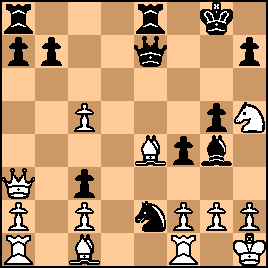
click for larger view22. Qd3
The Tournament Book claimed that 22. c6 was "much stronger and probably decisive. In fact, it blows the win for White: 22. c6 BxN 23. QxQ (or 23. cxb7 QxB 24. bxa8(Q) QxQ 25. Qc5 Bg8 26. Qxg5 Qe4 27. f3 Qe5 28. QxQ RxQ 29. Rd1 Bxc2 and Black, though the exchange down, has White nicely tied down and probably can save the game) RxQ 24. cxb7 Rb8 25. Bd5+ Bf7 26. Ba3 BxB 27. BxR Rxb7 28. Bxg5 f3! 29. g4 Rg7 30. h4 Be4 and Black, though down the exchange and a pawn, has pressure probably sufficient to hold the game. By contrast, the text should win.
22... Kh8
23. Qxb7 QxQ
24. BxQ BxN
25. BxR RxB
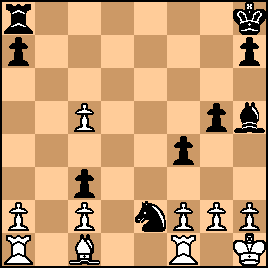
click for larger viewBased upon what follows, it appears that Maroczy was in time trouble with the move-30 time control approaching. The position is a theoretical win, but finding one's way through the labyrinth of possibilities with time running out must have been a nightmare. 26. Ba3?
26. Re1 should win (and probably 26. Rb1 as well). The text looks good theoretically, and should be good enough to win. But it was the beginning of a series of doubtful moves by Maroczy leading up to move 30 that should have allowed Marshall to escape. 26... f3
"!"--(Tournament Book)
The win was probably still there for Maroczy, but the situation had become even more tense, the position now being: 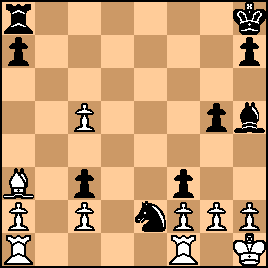
click for larger viewRefuting Marshall's attack over-the-board proved too difficult for Maroczy with what I am guessing was the limited time available. Luckily for Maroczy, and as I will discuss in my next post on this game, Marshall too seemingly fell victim to time pressure as move 30 approached. What followed, for all its flaws (easier to find with no time pressure and the chance to check calculations with computer assistance) was quite exciting, even if not very pretty. |
|
Jun-08-22
 | | KEG: Post IV
27. Rfd1
Hardly best (27. Rfe1 or 27. Rc1 or 27. h3 or 27. Bc1 are all better) but probably not blowing the win quite yet. The Tournament Book correctly noted that 27. g3 would run into 27...Bg4 (and would forfeit most of White's edge. 27... fxg2+
28. Kxg2 Nf4+
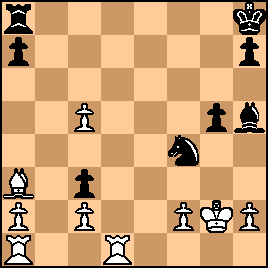
click for larger view29. Kf1?
After this careless blunder, Marshall should have been able to draw. To retain winning chances, and to avoid falling into the perpetual check for Black identified by <Honza Cervenka> on this site, Maroczy had to play 29. Kg1. 29... Be2+
30. Kg1
Forced. 30. Ke1?? loses to 30...Re8 (e.g., 31. f3 [else 31...Ng2 mate] BxR+ [31...Bb5+ also wins]32. Kf1 [not 32. KxB Ng2 and mate next move] Bxc2 33. c6 [there is nothing better] Bf5 34. Rc1 [everything else also loses] Bh3+ 34. Kg1 c2 35. c7 Nd3 and wins). After 30. Kg1, the position was:
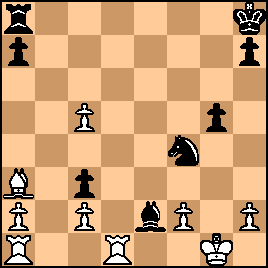
click for larger viewAs <Honza Cervenka> has demonstrated, Marshall could have drawn here with 30...Nh3+ 31. Kg2 [not 31. Kh1?? Bf3 mate] Nf4+ 32. Kh1 [If 32. Kg3 Nh5+ draws; and if 32. Kg1 Nh3+ draws] Nh3! 33. Kg2 [Forced. If 33. Rg1 Black wins with 33...Bf3+ 34. Rg2 Nf4] Nf4+ and draws by perpetual check. But instead, Marshall played:
30... g4??
This was Marshall's last move before the move-30 time control which may explain his miscalculation. The position after 30...g4?? was:

click for larger viewWith move 30 having been reached, Maroczy had time to calculate how to untangle his pieces and get his King to safety and out of any form of perpetual check: 31. Rd4 Rf8
31...Nh3+ likewise does not save the day for Black; e.g., 32. Kg2 Ng5 33. Kg3 h5 34. Rd5 Rg8 35. Bc1 Ne4+ 36. Kf4 Bf3 37. Rxh5+ Kg7 38. Re5 Rf8+ 39. Ke3 Nf6 40. Kd4 and wins. After 31...Rf8, the position was:
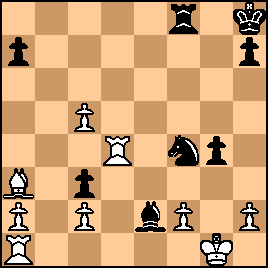
click for larger view32. c6 Nh3+
33. Kg2 Rxf2+
34. Kg3
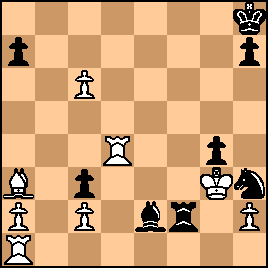
click for larger viewNow the White King escapes Black's clutches and White must win with his exchange plus and superior threats. |
|
Jun-08-22
 | | KEG: Post V
34... Rf3+
35. Kh4
Maroczy still had to be careful. 35. Kxg4? would blow the win after 35...Rd3+ 35... Nf4
Still trying to corral the White King, but by now it was hopeless. 36. c7
Leaving Black with yet another problem:
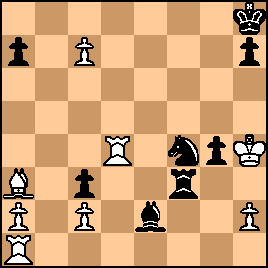
click for larger view36... Rh3+
37. Kg5 Ne6+
38. Kf6
Threatening mate, among other things:
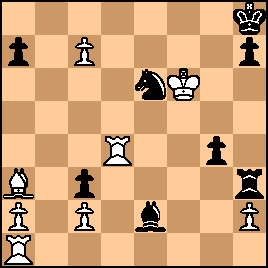
click for larger view38... Rh6+
39. Ke5

click for larger view1-0 |
|
|
|
|





